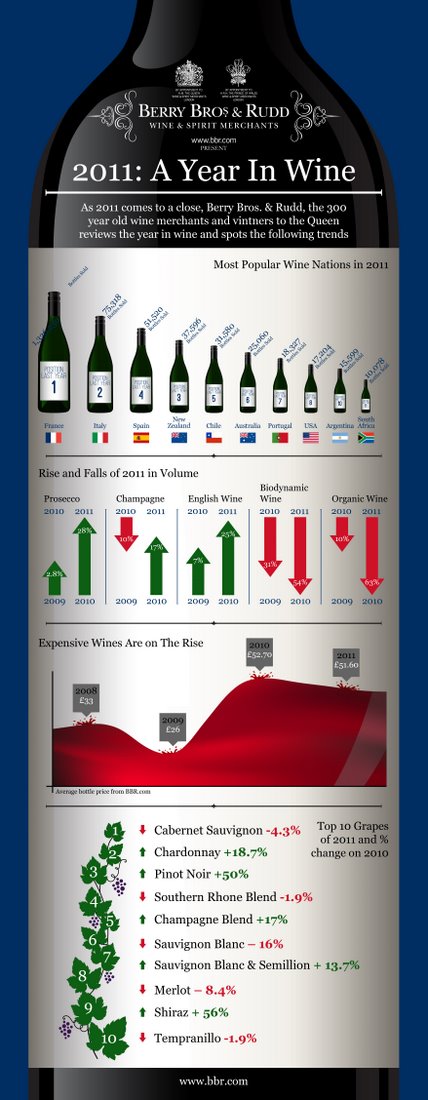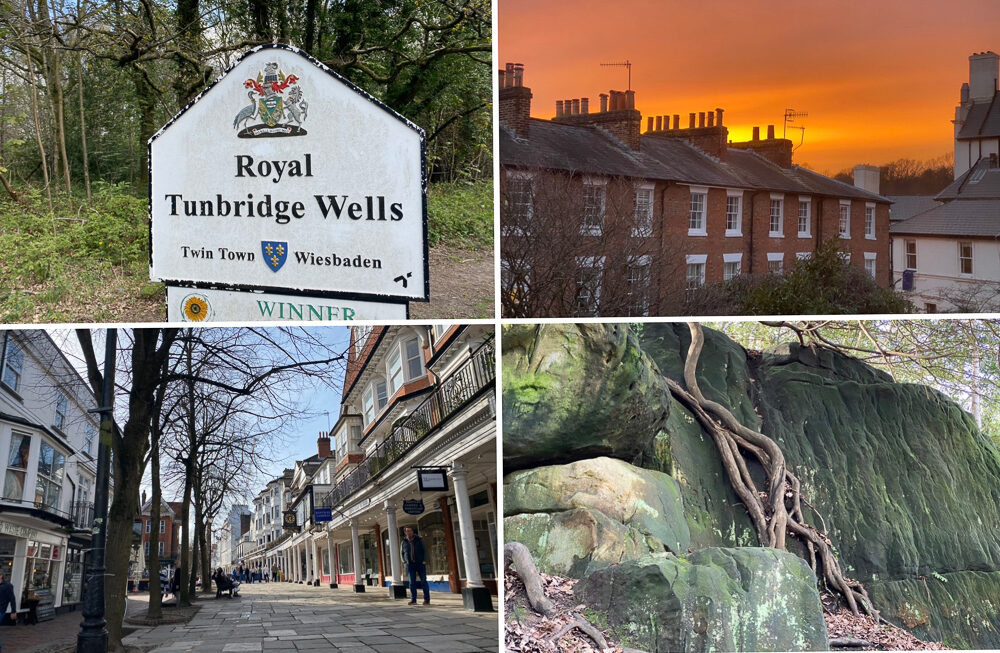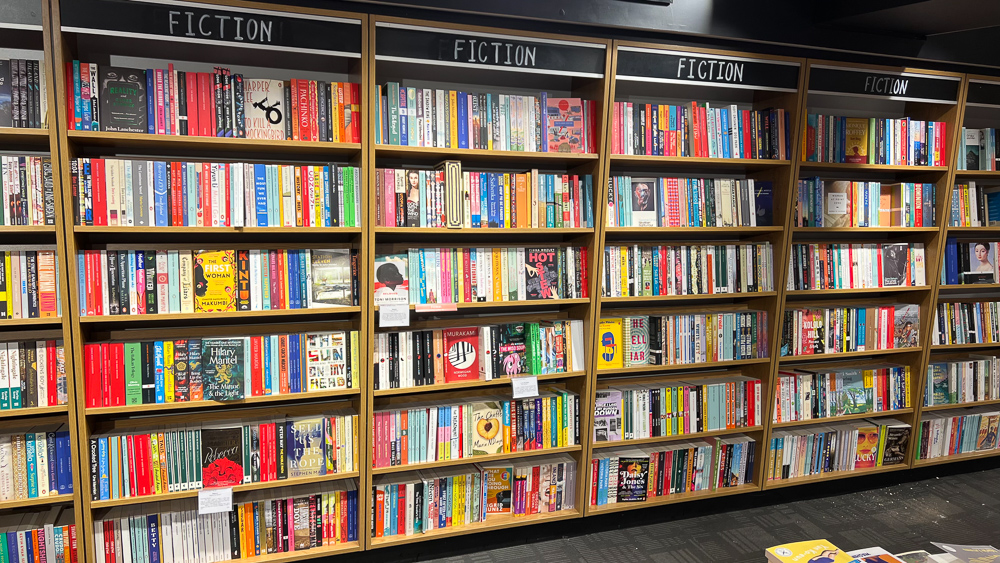I was really intrigued by this graphic from high-end wine merchant Berry Bros & Rudd. It shows the trends in their wine sales over the last year. Some are quite surprising; others perhaps less so.
The first point: it re-emphasizes that there is not just one wine market. Of course, to try to extrapolate these results and suggest they reflect trends across the whole world of wine is misguided. We are looking here at the fine wine niche. The rules here are quite different to commodity wine. Yet many wine commentators fail to make this distinction.
Look at the per bottle average price at bbr.com: it’s £51.60, up from £33 in 2008. Some people have money and are prepared to spend it on top wines. For many people, price is not a huge factor in their wine purchases.
Interestingly, Champagne dipped in 2010, but is bouncing back quite nicely.
English wine (and we are talking here largely about sparkling wine) is also showing impressive growth.
I’m puzzled by organic and biodynamic wine sales, and their decline. I would suspect that most customers of fine wine but wine according to its perceived quality, and not specifically because of how the grapes were grown. Perhaps these results reflect the fact that BBR have sold a lot of Bordeaux 2009 and 2010, and hardly any high-end Bordeaux is organic and biodynamic.
One of the most interesting results is the growth in sales of wines made from Chardonnay, Syrah and Pinot Noir. Pinot Noir sales have shown a massive 50% growth; Syrah an even bigger 56%. Chardonnay has shown an impressive 17% growth.
The bottle graphic of sales by country is clever. The height of the bottle seems to reflect the sales, but it’s actually the volume of the bottle (as far as I can tell). The height would have made the higher-selling nations look disproportionately large. I was impressed by how many bottles of wine from New Zealand and Portugal BBR have sold.
All in all, very interesting.
11 Comments on Berry Bros Year in Wine: interesting trends?



I can only imagine that the average bottle price is heavily influenced by the 2010 bordeaux primeurs prices. It beggars belief otherwise. Either that, or need to get a job at Berrys!
I wonder whether Portugal is influenced by 2009 Port declaration? However still impressive.
Also whilst we can extrapolate what is going on in the wine world from this, it may give us a hint into the future. If you follow the belief that indie merchants are the game changers then it probably follows that London merchants are the most advanced in the game – that said BBR are not your average indie merchant and are far less cutting edge and far more traditional than some.
Syrah could be explained by the strong 2009/10 in the Rhone?
Chardonnay & Pinot Noir presumably on the back of 2009 Burg primeurs?
Very interesting read. Especially the fact that organic and biodynamic wines are down 53% and 64% in 2011 after a decline in 2010. While skewed by the Bordeaux sales, I wonder if another contributing factor is classification (i.e. certification requirements) ?
Australia also seem to have given some ground to their Tasman rivals… exchange rate issues perhaps?
The graphic does indeed provide very interesting reading. The Bio-dynamic and organic slide reflects reality – people who drink wine for enjoyment, have a good level of knowledge and trust the merchant/producer they buy from care not at all about those two elements. The fact that most conscientious and quality producers follow high standards of vineyard husbandry and have more or less always done so may be a factor and the end purchaser will be aware of this.
Would DRC be classified as Bio-D/Organic? It won’t impact stats by volume, but definitely by value! I suppose Corney & Barrow would see more of that trend?
Portugal as increased a lot the exportations of wine to the rest of the world, impulsed by the urge of the crisis in national market, so the exportations were the salvation. One other point, the portuguese wines have increased a lot there quality, impressive for the price. And we have a lot of indigenes grapes to be discovered, diferent regions exist in Portugal making wines very diferent from one another…Alvarinho(white) from the North, Síria(white) from Bairrada, Baga(red) from Bairrada, Vinhão(red) from the north,Touriga Nacional(red) the queen of grapes in Portugal, and many others, incredibly sparkling wine from Távora-Varosa(DOC) and Bairrada. This resides the success of Portugal, it was there to be discovered. A good year to you all!:)
Perhaps a little surprised that neither Nebbiolo or Sangiovese made it into the ‘Top 10 Grapes’ category, more so given that Italy is ahead of Spain in the ‘Most Popular’ graphic while Tempranillo still makes into the top 10. Were it not for the fact that the average bottle price here is so high, I might have put price down to the omission of Nebbiolo. That’s despite the fact that, although Barbaresco and Barolo are by far its best expression, you can still pick up wonderful DOC Langhe Nebbiolo for under £30 a bottle (although, admittedly, I haven’t looked at the Berry Bros website to see if they’ve a fair selection of ‘standard’ Nebbiolo). I think this just confirms my suspicion that many people just don’t ‘get’ Nebbiolo, which is a great shame given that it’s one of the few grapes that truly has a sense of place and doesn’t relish international soil – this for me is one of the associated pleasures of the variety. All the other grapes flourish in many countries, which explains their inclusion in the list (apart from Tempranillo). Still strange that Sangiovese doesn’t get a nod.
Morning Tony,
Rest assured that Nebbiolo & Sangiovese are hovering just outside the Berrys’ ‘Top 10’ ready to dive in!
I agree with your comment about people not ‘getting’ Nebbiolo but with communication & exposure to fine wines at reasonable prices I think the penny will drop…which is exactly what I’m trying to do from my home in Barolo! For example pls check out the four Langhe Nebbioli showing on bbr.com, from Messrs. Alessandria, Bondonio, Fontana & Rosso all at sub £20 RSP.
And my not just Nebbiolo,I feel strongly that this applies to other grapes along the ‘Apennines of Excellence’ (nice title for a book!), such as Sangiovese, Aglianico, Gaglioppo, Nerello Mascalese…
And to see how we’re getting on here’s a date for your diary: Sept 6th pm for Berrys’ Grand Tour Italian tasting in London (probably Lindley Hall)!
David.
David you are correct, Nebbiolo certainly deserves to be up there and its great that you have chosen to move to Piemonte to fight the Good Cause. In addition to the great wines on bbr, check out the selection of Nebbiolo based wines on piemonte-wines.com
Ben, I think you’re right that discerning drinkers don’t worry about organic labels. This may be the reason why so many top producers who operate organically or near-organically don’t go to the trouble of certifying.
I also feel that the increased publicity given to Naturally made wines over the last 12 months has pushed the eco-aware consumer away from the more traditional organic wines.
Our sales of sparkling wine mirror the findings – huge interest and buying of English fizz….
We can’t disgorge fast enough now having enough 2 year lees-aged stock.
Trouble is with this year’s weather there may very well be a shortage of Pinot Noir, Chardonnay etc
in England…though many of us have stock ageing from previous good years ( 09/10)